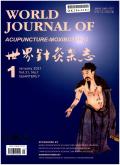Mechanism of electroacupuncture on rats with primary dysmenorrhea based on microRNA expression spectrum and PI3K/Akt/mTOR signaling pathway
IF 1.3
4区 医学
Q4 INTEGRATIVE & COMPLEMENTARY MEDICINE
引用次数: 0
Abstract
Objective
To investigate the effect of electroacupuncture (EA) on microRNA (miRNA) expression spectrum and PI3K/Akt/mTOR signaling pathway in uterine tissue of rats with primary dysmenorrhea (PDM), and to explore the potential mechanism of EA in the treatment of PDM.
Methods
Thirty female SD rats, weighted (200 ± 20) g were randomly divided into control group, model group and EA group, 10 rats in each group. By using subcutaneous injection of estradiol diphenhydrate combined with intraperitoneal injection of oxytocin, PDM models were established. Rats in the EA group received EA at “Sanyinjiao”(SP6) and “Guanyuan”(CV4) at dense waves and a frequency of 50 Hz, once a day, 20 min each time, for 10 consecutive days. After the 10-day intervention, samples were collected and transmission electron microscopy was used to observe the ultrastructural changes of the cells in uterine tissue in each group. With RNA-seq method, the changes of miRNA expression spectrum in rat uterine tissue were detected. Bioinformatics analysis such as GO functional annotation and KEGG pathway was performed according to differentially expressed miRNAs. Differentially expressed miRNAs were verified by qRT-PCR. Endometrial stromal cells were selected as the target cells and transfected; and they were divided into control group, NC mimics group, mimic miR-144–3p group, NC inhibitor group and inhibitor miR-144–3p group. The apoptosis was determined by using flow cytometrydetect apoptosis, the miRNA and protein expression of PI3K/Akt/mTOR signaling pathway were detected by qRT-PCR and Western blot in each group separately.
Results
1. Transmission electron microscope. (1) Control group: no obvious morphological changes in the uterine tissue. (2) Model group: fibroblasts in uterine tissue were irregular, the edema was presented in cellular cytoplasm, the nuclei were irregular and mitochondria swollen seriously; the rough endoplasmic reticulum was expanded moderately. (3) EA group: fibroblasts were spindle-shaped and pyknotic, the cytoplasm increased in electron density, the nuclei were slightly irregular and pyknotic, mitochondria were oval in shape, with little swelling and vacuolation; the rough endoplasmic reticulum was expanded slightly and retained, with a small amount of degranulation. 2. Compared with the control group, there were 26 differentially expressed miRNAs in the uterine tissue of rats with PDM. After EA intervention, the expression of miR-144–3p was significantly up-regulated. GO functional analysis of differentially expressed miRNAs in PDM rats after EA showed that the biological functions involved calcium transmembrane transporter activity, mitogen-activated protein kinase binding, epithelial cell migration, tissue migration, etc. 3. KEGG pathway analysis showed that PI3K/Akt signaling pathway, MAPK signaling pathway and calcium signaling pathway were enriched. Mimic miR-144-3p increased the apotosis of endometrial stromal cells, and decreased the mRNA and protein expression of PI3K,Akt, and mTOR (P < 0.01).
Conclusion
EA can optimize the cell morphology in the uterine tissue of rats with PDM and affect the miRNA expression spectrum, which may be associated with the effect of EA for up-regulating miR-144–3p expression in endometrial stromal cells, suppressing PI3K/Akt/mTOR signaling pathway and causing apoptosis.
基于microRNA表达谱和PI3K/Akt/mTOR信号通路的电针治疗大鼠原发性痛经的机制
目的观察电针(EA)对原发性痛经(PDM)大鼠子宫组织microRNA (miRNA)表达谱及PI3K/Akt/mTOR信号通路的影响,探讨电针(EA)治疗PDM的可能机制。方法30只雌性SD大鼠,体重(200±20)g,随机分为对照组、模型组和EA组,每组10只。采用皮下注射二苯雌二醇联合腹腔注射催产素建立PDM模型。EA组大鼠在“三阴角”(SP6)和“冠源”(CV4)处以密集波,频率为50 Hz,每天1次,每次20 min,连续10天。干预10 d后,取标本,透射电镜观察各组子宫组织细胞超微结构变化。采用RNA-seq方法检测大鼠子宫组织中miRNA表达谱的变化。根据差异表达的mirna进行GO功能注释和KEGG通路等生物信息学分析。通过qRT-PCR验证差异表达的mirna。选择子宫内膜基质细胞作为靶细胞转染;将其分为对照组、NC模拟组、模拟miR-144-3p组、NC抑制组和抑制miR-144-3p组。采用流式细胞术检测细胞凋亡,采用qRT-PCR和Western blot分别检测各组细胞中PI3K/Akt/mTOR信号通路的miRNA和蛋白表达。透射电子显微镜。(1)对照组:子宫组织无明显形态学改变。(2)模型组:子宫组织成纤维细胞不规则,细胞质水肿,细胞核不规则,线粒体严重肿胀;粗面内质网适度扩张。(3) EA组:成纤维细胞梭形缩窄,细胞质电子密度增大,细胞核略不规则缩窄,线粒体卵圆形,微肿胀,空泡形成;粗面内质网略有扩张和保留,有少量脱粒。2. 与对照组相比,PDM大鼠子宫组织中有26个差异表达的mirna。EA干预后,miR-144-3p的表达明显上调。PDM大鼠EA后差异表达mirna的GO功能分析显示,其生物学功能涉及钙跨膜转运蛋白活性、丝裂原活化蛋白激酶结合、上皮细胞迁移、组织迁移等。KEGG通路分析显示,PI3K/Akt信号通路、MAPK信号通路和钙信号通路富集。Mimic miR-144-3p增加子宫内膜基质细胞凋亡,降低PI3K、Akt、mTOR mRNA和蛋白表达(P <;0.01)。结论EA可优化PDM大鼠子宫组织细胞形态,影响miRNA表达谱,这可能与EA上调子宫内膜间质细胞miR-144-3p表达,抑制PI3K/Akt/mTOR信号通路,导致细胞凋亡有关。
本文章由计算机程序翻译,如有差异,请以英文原文为准。
求助全文
约1分钟内获得全文
求助全文
来源期刊

World Journal of Acupuncture-Moxibustion
INTEGRATIVE & COMPLEMENTARY MEDICINE-
CiteScore
1.30
自引率
28.60%
发文量
1089
审稿时长
50 days
期刊介绍:
The focus of the journal includes, but is not confined to, clinical research, summaries of clinical experiences, experimental research and clinical reports on needling techniques, moxibustion techniques, acupuncture analgesia and acupuncture anesthesia.
 求助内容:
求助内容: 应助结果提醒方式:
应助结果提醒方式:


